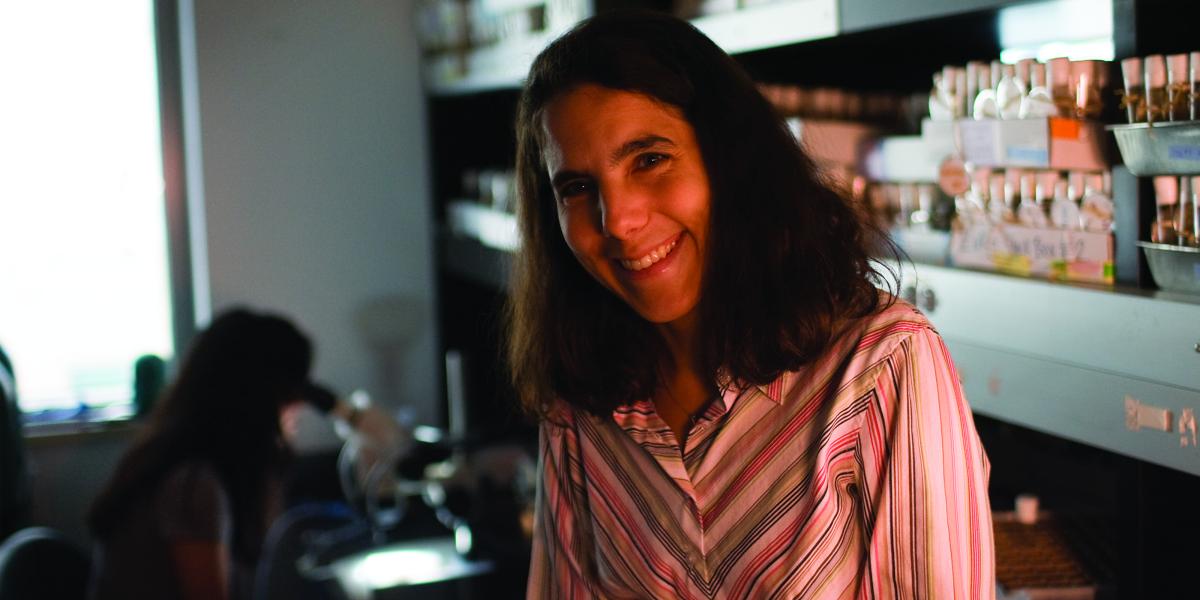Fertility and the Fruit Fly
With a lifespan that runs from birth to death in little more than a month, the average female fruit fly doesn’t get a lot of second chances: Her ovaries must be finely tuned to bequeath the optimal genetic inheritance on her offspring. “Reproduction is the whole point of anything being alive,” says assistant professor of Biochemistry and Molecular Biology Daniela Drummond-Barbosa, PhD. “You have to be really tied to the environment if you’re an ovary because you have to maximize production when things are good and shut down production when things are bad.”
Those high stakes make Drosophila melanogaster the perfect model organism for Drummond-Barbosa’s studies of the effect of diet on the female reproductive system. Women and their doctors have long known that both anorexia and obesity can short-circuit the menstrual cycle, but scientists have lacked a clear picture of the cellular mechanisms that translate what’s for dinner into a successful pregnancy.
In her laboratory, Drummond-Barbosa has identified signaling pathways that link nutrition and egg production (oogenesis). In the process she has uncovered new insights into stem cell regulation (in the case of fruit flies, the ovary harbors stem cells through adult life) and ovarian biology. “Because we’re studying the effect of the diet and the endocrinology of the organism, we touch on a lot of different areas,” says the Brazilian native, whose appointment at the Bloomberg School of Public Health began this summer. “If you understand the mechanisms involved, you can control biology with diet before it gets to a disease stage.”
In January 2009, the Proceedings of the National Academy of Sciences published Drummond-Barbosa’s analysis (with H.J. Hsu, who joined the Bloomberg School faculty in July) of the effects of a protein-rich diet on fruit fly fertility. The series of studies honed in on an insulin-like hormone that mediates the influence of diet and the passage of time on the microenvironment that maintains stem cells in the Drosophila ovary.
“Because there are so many similarities in biological processes between the fruit fly and humans, we learn about how diet can affect mammalian stem cells in general, and also the mammalian ovary,” she says. And while the human ovary lacks the stem cells present in its laboratory counterpart, that divergence poses an added boon at the bench. “The way stem cells behave in the fruit fly ovary is similar to how stem cells in humans behave,” she says. “We can understand how diet controls stem cells in other tissues like the gut, the skin and even in cancer.”
As a basic scientist, Drummond-Barbosa lays the groundwork for the clinicians who counsel women in their quest to start a family—and much work remains. “It’s still a leap to application,” she says. “We know that what the flies eat has a big impact on their egg production and on how well their stem cells work, but we still haven’t quite dissected out what components of the diet have each specific effect.”
Ultimately, though, the clues emerging from her work have implications that could span generations. “Women are born with a set number of oocytes and that number doesn’t increase over the life course,” she muses. “If a woman has a history of infertility, it’s not inconceivable that it’s her own fetal development—when oocytes were being made—at play. Her mother’s diet during pregnancy might have affected her fertility.”
